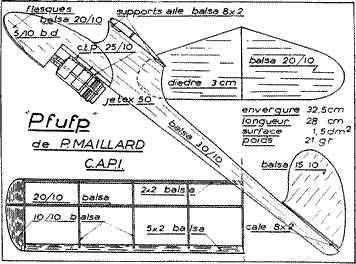Pfufp
Taking the lead in promoting the Jetex cause in France was the premier French aeromodelling magazine, Le Modèle Réduit d'Avion
Typical of the Jetex plans it published was the little 'Pfufp', appearing in a 1951 issue. It was designed for the (original) Jetex 50 by P.Maillard.
Dimensions are:
wingspan: 32.5 cm (12.8 in.)
dihedral: 3 cm (1.2 in.)
length: 28 cm (11 in.)
area: 1.5 dm2 (23.25 sq. in.)
weight: 21 g
(0.74 oz.)
This copy of the plan was republished by Vic Smeed in his anthology
Flying Models - Favourites of the Fifties (Argus Books 1988). Thanks to Bill Henderson for this contribution.
Graham Knight, who has adapted 'Pfupf' for Rapier power, writes:
"I didn't change very much – the most obvious change was to make it smaller
for Rapier L1 power so I reduced the span to 11". The Rapier motor is
lighter than an equivalent Jetex so I had to move it forward, I also omitted
the negative tailplane incidence.
The only other changes were to the wing construction. I don't like LEs set
on edge as on the original model so I changed that. I also used a full depth
main spar and added some triangular gussets at the dihedral joint.
"If you compare it to the original plan it's obvious what I've changed.
Note there are no dimensions – just print it at 11" span for L1, or somewhere
between 13" and 15" for L2 depending on what rating your L2s are, and how
exiting you want your flights to be!
"I managed to lose mine last year at Old Warden, first flight of the day and
it climbed steeply to a good couple of hundred feet and was into lift, 5
minutes later and I lost it in the binoculars.
"The model would benefit from
a DT, although it's quite quick to build another.
One thing I learned from flying it is that there is a weakness behind the
pylon, I suggest adding thin (1/64") ply doublers either side of the pylon
to strengthen the pylon/fuselage joint, and extend them along the tailboom
for 1/2" or so behind the pylon.
Anyone considering building from the original plan for Jetex power should
note that it was designed for the original aluminium cased motors, so if you
use a steel motor you will need to allow for the extra weight."
|
 |
Click image to view or download enlarged dimensioned plan

Graham Knight's adaptation of 'Pfupf' for Rapier power
Click image to view
or download construction plan

|

